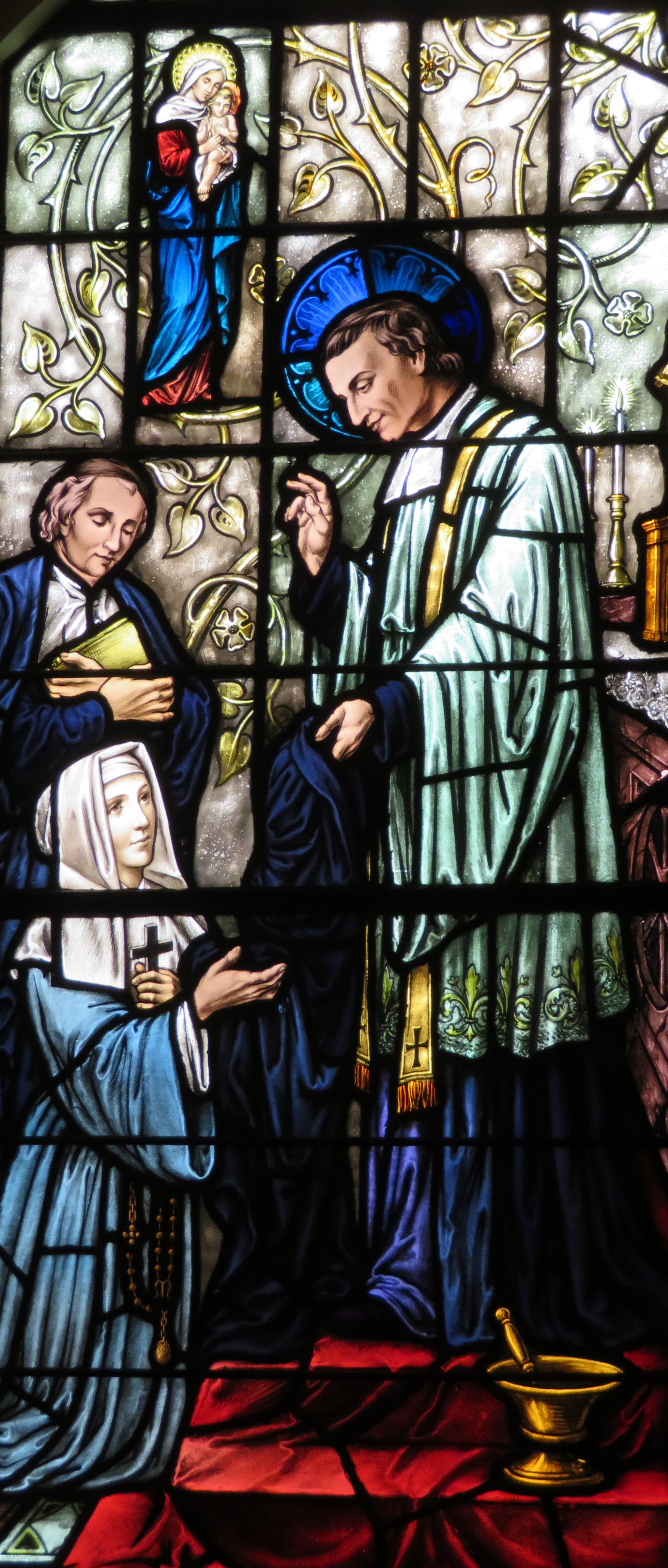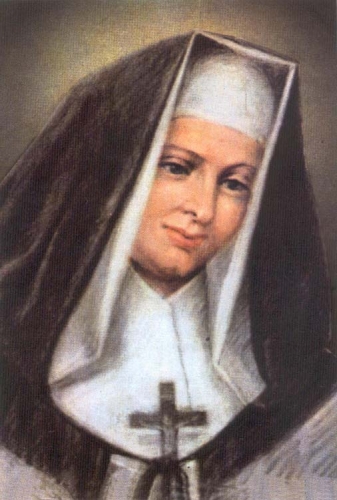The Initial Call of Sister Marie Louise Trichet
Fr. Donald Macdonald, SMM
W hen the disciple is ready,” it has been said, “then the teacher will appear.” Unless I am ready to receive what comes to hand in the present moment, it is unlikely that I shall assimilate or learn much. If I do not digest the bread available now, I cannot take richer food elsewhere. It would prove indigestible. But if I am alert and ready, I am in a position to pick up something of what is here now.
God’s Providence, expressed in Jesus’ resurrection from a grave, means that in the present moment God offers himself to us in Christ. The Gospel of St. John, for example, can be read in that light, when after the initial call of the would-be disciple in wonder, he is told that, “you will see heaven opened, and the angels of God ascending and descending upon the Son of man” (Jn. 1: 51). God is always here in Christ, but the underlying theme of Jacob’s Ladder, warns us that we may be asleep and never know it.
MEETING MONTFORT
The initial call of Marie Louise Trichet, the woman who was to become a co-founder with St. Louis Marie de Montfort of the Daughters of Wisdom, and was beatified in 1993, illustrates that. She was alive to the Providence of God as seen in and through the person of Fr. de Montfort. And given the personality and witness of Montfort, it is really remarkable.
She grew up in a devout family with exemplary parents. As a young girl she would visit the poor in their houses or in hospital. In 1701, Fr. de Montfort, a newly ordained priest, became chaplain to the poorhouse in Poitiers, her home town. Although the building itself was new, the place was in a dreadful state. The poorest people and the dregs of society were forced to stay there. Montfort, their chaplain, choose to live as one of them, and accepted no salary.
Mary Louise’s sister Elizabeth heard him preach and felt that she was listening to a saint. Marie Louise had wanted to ask him about the possibility of becoming a nun. “My child, who sent you to me?” he asked her when they met. “My sister,” she said. “No, my child,” she was told, “it was not your sister but the Blessed Virgin who sent you to me.”
Their lives were to dovetail to such an extent that Marie Louise even died on the same day, at the same time and in the same place as Fr. de Montfort in 1759. Increasingly, their interests were shared, and remarkably expressed in the way of life they adopted.
INMATE OF THE POORHOUSE
Consider what happened to this nineteen year old woman from a respected family, once she allowed herself to be guided by Fr. de Montfort. He had formed a prayer-group of some of the poor and handicapped under the leadership of a blind woman. He called the group ‘Wisdom’ and gave them a cross to gather round when they met for prayer. Marie Louise was invited to join them.
To further her desire to become a religious, Fr. de Montfort advised her to live in the poor-house. “Take me as an inmate” she said to the management, and she spent the next ten years there. Leaving home, she received a sort of religious habit from Fr. de Montfort on February 2, 1702, probably not unlike the grey calico worn by the inmates.
This is extraordinary. The priest has an obvious influence on this young woman. She stayed there with no security other than the word of Fr. de Montfort. She evidently saw it as God’s word for her, and as the disciple, she was ready to receive. Three times she approached formal religious congregations but each time circumstances brought her back to the poorhouse. For much of the time, Fr. de Montfort was away preaching and engaged in other work, yet still she persevered. Again, as we glimpse the unsettled life of her guide, it seems extraordinary.
TRUST IN GOD
Circumstances at Poitiers forced Fr. de Montfort to leave the poorhouse. He went to Paris for help in forming a religious congregation but found none – “those friends I once had in Paris have deserted me. I have not counted on the goods that were to come to me from Madame de Saint André, nor shall I count on them.”
As to her own position he writes, “please do not think that the distance between us and my apparent silence mean that I have forgotten your charity towards me and the charity I owe you . . . your wishes (to be a religious) are just as strong and eager and persistent as ever . . . so . . . put your trust in God. Be sure of this, you will obtain from him even more than you think. Heaven and earth would pass away before God would break his promises and allow anyone who hoped in him to be frustrated in their hopes.”
A HOME FOR WISDOM
What is she to make of Fr. de Montfort’s self-analysis when asking for her prayers that he might be, “sufficiently equipped to serve as a place of rest for Wisdom in a world where he is rejected and without a home?” He himself is homeless and without worthwhile employment in a city where, “both men and demons . . . slander me, scoff at me, destroy my good name, put me in prison . . .”. Apart from one or two priests, the poor-house management, and perhaps others making a living from exploiting the people there, did Fr. de Montfort really upset a dozen people in the city? Did he matter much to any of them? The letter to the young Marie Louise, alone, working, writing and wondering if she would ever be a professed religious, is full of himself and his hard times.
More particularly, he emphatically asks her prayers that he be given authentic Wisdom: “nothing can resist your prayers . . . lively faith and a firm hope. So pray, entreat God, plead for me to obtain divine Wisdom. You will obtain it . . for me.”
What Fr. de Montfort asks is that he be possessed by Jesus Christ. He longs to be transfigured by what he glimpses of the glory of God on the face of Christ, and so become just like the Christ he sees. This is Wisdom Incarnate in the person of Jesus. So he asks, “when shall I possess this loveable and mysterious Wisdom? When will Wisdom come to live in me?” Not before too long, he trusts, given Marie Louise’s prayers.
“I feel that you are still asking God that by crosses, humiliations and poverty, I may acquire divine Wisdom. Be brave, my dear daughter, be brave. I am grateful to you . . .”. Again, what is Marie Louise meant to make of that? She came to understand what her guide saw, that a price has to be paid to be possessed by Wisdom Incarnate. What Fr. de Montfort asked for above, “. . . form the . retinue of divine Wisdom which he brings into the lives of those in whom he dwells.” They may follow from the total gift of self to God in Christ. To live for God alone at one with his will, will mean that we may be at odds with our unregenerate selves and with others to the extent that the tension may be resolved in crucifixion.
“God does not ask for your help, he asks for you,” said Eckhart, and went on to say that detachment compels God to love us. In so far as we are open and willing to receive, God will give. If we are ready, the teacher will appear. Marie Louise’s initial call from God surely follows that pattern. What she saw in the person and way of life of Fr. de Montfort rang true for her. She made it her own, living for ten years in the poorhouse, until with two companions and the approval of the bishop of La Rochelle, she was pro- fessed as a religious on August the twenty second, 1715.
Footnote
‘Letter to Marie Louise Trichet from Paris’, in Letter 16 page 21 from God Alone, Montfort Publications, New York 1987. All quotations are from this letter.

Stain Glass Window: Blessed Marie Louise and St. Louis de Montfort: Chapel of Infant Jesus Parish, Port Jefferson, NY
The Parish was first built in the early 1900’s, and the Chapel was built in 1941. The Chapel resides on the grounds of a hospital in Port Jefferson originally founded by the Daughters of Wisdom.
A picture of Blessed Marie Louise appears below.



